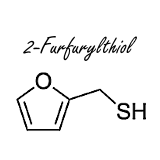|
How ginger banishes bad breath
If you suffer from bad breath after drinking coffee, and perhaps after taking protein shakes, German food chemists from the Technical University of Munich have found a solution to your problem. If you like fresh ginger.
Bad breath
Bad breath is often the result of sulphurous gases released in the throat and oral cavity. An example of such a substance is 2-furfurylthiol. 2-Furfurylthiol is also a component of coffee, and it causes the bad breath some coffee drinkers have.
The enzyme sulfhydryl-oxidase-1 neutralises substances like 2-furfurylthiol in saliva, and cells make more of that enzyme by exposure to 6-gingerol. And so the researchers wondered whether 6-gingerol can fight bad breath.
6-Gingerol
6-Gingerol is the most important active ingredient in fresh ginger. When you dry ginger, 6-gingerol changes into shogaol. Shogoal is more pungent than 6-gingerol.


Sulfhydryl-oxidase-1
The researchers suspended 6-gingerol, dissolved in a liquid [1.7 millimol], in the mouth of volunteers, and then determined the concentration of sulfhydryl-oxidase-1 in their saliva. It increased sharply after just a few seconds.

Bad breath
In another trial, the researchers put 2-furfurylthiol in the mouth of volunteers, and looked at how much of that substance they found in the saliva. At the bottom left you can see that 6-gingerol made the mouth odor chemical disappear faster.

At the top right, you can see that, accoding to a panel of smell experts, 6-gingerol made the volunteer's breath smell less hellish.
Conclusion
"Orosensory prestimulation with 6-gingerol was found to induce an increased abundance of the salivary sulfhydryl oxidase 1 catalyzing the oxidative decline of free mercaptans, such as the sulfury-roasty smelling 2-furfurylthiol, thus leading to lower odorant levels in the exhaled breath and, in consequence, a reduction of the perceived sulfury after-smell", write the researchers.
"The chemosensory modulation of sulfhydryl oxidase 1 may therefore be considered as an important component of an efficient molecular network triggering oral cleansing mechanisms after food ingestion and may open new avenues for innovative oral care applications suppressing a long-lasting after-smell."
Source:
J Agric Food Chem. 2018 Jul 25;66(29):7740-9.
More:
Polyphenols in juice and tea clear bacteria from your teeth 22.10.2009
Bad breath from proteins? Green tea helps 24.03.2009
Archives:
Ginger
|
|








